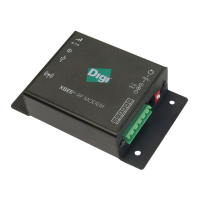© 2014 Digi International Inc. 28
XBee/XBee-PRO
®
DigiMesh 2.4 User Manual
• Deploy all modules in the network with the default DH/DL of 0xFFFF.
• Issue an ATAGFFFF command on the aggregator node.
Following the preceding sequence would result in all of the nodes in the network which received
the AG broadcast to have a DH of 0x0013a200 and a DL of 0x4052c507. These nodes would
have automatically built a route to the aggregator.
Example 2: To cause all nodes in the network to build routes to an aggregator node with a MAC
address of 0x0013a2004052c507 without affecting the DH/DL of any nodes in the network the
ATAGFFFE command should be issued on the aggregator node. This will cause an AG broadcast
to be sent to all nodes in the network. All of the nodes will update their internal routing table
information to contain a route to the aggregator node. None of the nodes will update their DH/
DL registers (because none of the registers are set to an address of 0xFFFE).
Node Replacement
The AG command can also be used to update the routing table and DH/DL registers in the
network after a module is replaced. The DH/DL registers of nodes in the network can also be
updated. To update only the routing table information without affecting the DH/DL registers then
the process of Example 2 above can be used. To update the DH/DL registers of the network then
the method of Example 3 below can be used.
Example 3: The module with serial number 0x0013a2004052c507 was being used as a network
aggregator. It was replaced with a module with serial number 0x0013a200f5e4d3b2. The
AG0013a2004052c507 command should be issued on the new module. This will cause all
modules which had a DH/DL register setting of 0x0013a2004052c507 to update their DH/DL
register setting to the MAC address of the sending module (0x0013a200f5e4d3b2).
XBee Device Placement
For a network installation to be successful, the installer must be able to determine where to
place individual XBee devices to establish reliable links throughout the network.
Link Testing
A good way to measure the performance of a network is to send unicast data through the
network from one device to another to determine the success rate of many transmissions. To
simplify link testing, the modules support a loopback cluster ID (0x12) on the data endpoint
(0xE8). Any data sent to this cluster ID on the data endpoint will be transmitted back to the
sender.
The configuration steps to send data to the loopback cluster ID depend on the AP setting:
AT Configuration (AP=0)
To send data to the loopback cluster ID on the data endpoint of a remote device, set the CI
command value to 0x12. The SE and DE commands should be set to 0xE8 (default value). The
DH and DL commands should be set to the address of the remote (0 for the coordinator, or the
64-bit address of the remote). After exiting command mode, any received serial characters will
be transmitted to the remote device, and returned to the sender.
API Configuration (AP=1 or AP=2)

